Your Planets
Portraits of the Planets
Aspects between Planets
The planetary ages
The planetary families
Planets in Signs
The Planets in comics


In the article “Declination concentration-dispersion index”, I briefly approached the theme of global astrology and more precisely my personal experience in this field. I suggest that you continue this foray into this field by developing in a little more depth the method used by the astrologers I spoke to you about previously.
Gustave-Lambert Brahy was born in Liège (Belgium) in 1894. A writer, poet and chartered accountant, he is best known for his brilliant career as an astrologer. In 1926 he founded the Belgian Astrological Institute (which later became the Cebesia or Belgian Center for the Scientific Study of Astral Influences) and the magazine Demain in which its global and financial forecasts regularly appeared.
.png)
.png)
.png)
If he did not experience the same success in all areas, it cannot be denied that he was a remarkable forecaster in his specialty: financial and stock market astrology. I now suggest that you briefly discover Brahy’s working method.
1. Method of valuation of planetary angles
To establish his financial and stock market forecasts, Brahy uses the different planetary cycles, except those of Pluto, by valuing them using three indices: “the index of pure aspects” considered as a qualitative valuation and the “cycle coefficients or rarity coefficients”, and the index of “volume coefficients”, considered as a quantitative valuation.
Initially (qualitative valuation), he distinguishes the favorable aspects from the unfavorable aspects. Like most astrologers of the time and like many astrologers today, he considers the favorable aspects to be the trine, the sextile and the semi-sextile and the unfavorable aspects to be the conjunction, the semi-square, the square, the sesqui-square and finally the opposition.
Finally, he grants the following orbs to the aspects:
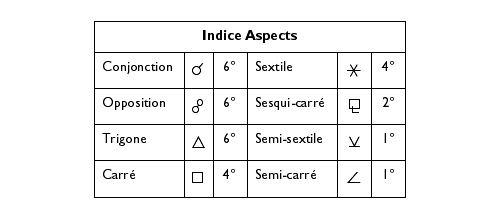
Brahy notes, however, that it would have been better to widen the orbs to 10° for conjunction and 8° for opposition.
Secondly (quantitative valuation), it determines the “cycle coefficients” or “rarity coefficients”. This idea comes to him from the simple observation that “the movements of the world economy are all the more important as they are supposed to correspond to rarer planetary configurations” (1).
The duration of the planetary cycles, apart from those formed with the then undiscovered planet Pluto, is approximately as follows:
▶ Neptune-Uranus 170 years
▶ Uranus-Saturn 45 years
▶ Saturn-Neptune 36 years
▶ Saturn-Jupiter 20 years
▶ Uranus-Jupiter 14 years old
▶ Neptune-Jupiter 13 years
In order to simplify the calculations, Brahy operates a division of these cycles by 6 (approximately) and he obtains the “cycle coefficients” following:
“Cycle coefficients”
▶ Neptune-Uranus 28
▶ Uranus-Saturn 7
▶ Saturn-Neptune 6
▶ Saturn-Jupiter 3
▶ Uranus-Jupiter 2
▶ Neptune-Jupiter 2
Thirdly, Gustave-Lambert Brahy will bring in the “volume coefficients”. Admittedly, taking into account the volume of the planets may seem a little simplistic today, but you should know that daring to use this astrometric element when astro-psychology was the essential dogma of the time is a remarkable fact.
Brahy takes the following data into account:
▶ Volume of Neptune: about 4 times that of Earth.
▶ Volume of Uranus: about 4 times that of Earth.
▶ Volume of Saturn: about 9 times that of Earth.
▶ Volume of Jupiter: about 11 times that of Earth.
“By combining these last figures together to evaluate more or less the value of the aspects of two planets, in proportion to their respective volumes, we would obtain the following gradation…”
“Volume coefficients”
▶ Neptune-Uranus 4 × 4= 16
▶ Uranus-Saturn 9 × 4= 36
▶ Saturn-Neptune 9 × 4= 36
▶ Saturn-Jupiter 11 × 9 = 99
▶ Uranus-Jupiter 11 × 4 = 44
▶ Neptune-Jupiter 11 × 4 = 44
Finally, Brahy performs a combination of “Cycle-Volume coefficients” by multiplying the values of the two coefficients, which gives after simplification by 30:
‘“Combined Cycles-Volumes coefficients”
▶ Neptune-Uranus 15
▶ Uranus-Saturn 9
▶ Saturn-Neptune 7
▶ Saturn-Jupiter 10
▶ Uranus-Jupiter 3
▶ Neptune-Jupiter 3
In summary Brahy calculates the value of the different planetary angles by multiplying the index of the aspects by the combined Cycles-Volumes coefficients if the aspects are in orb and if the aspects are exact the values are doubled.
He draws tables allowing him to draw diagrams representing the economic and stock market evolution of the world for the period from 1820 to 1940.
Here is an example of a diagram obtained by plotting the years from 1901 to 1933 along the abscissa and along the ordinate the values of the aspects according to the previous technique:
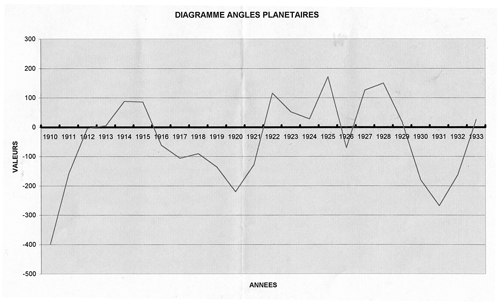
The significant dip that we see during the period from 1906 to 1910 corresponds to the world economic crisis that we experienced during these years. The next trough corresponds to the First World War and its aftermath (1914–1921) and the third trough corresponds to the Great Depression of 1929 to 1931.
By comparing the diagram thus obtained with that illustrating the volume of business in the USA, we note a surprising parallelism.
To refine his research when he wanted to study a specific period more precisely, for example that from 1928 to 1932 which corresponds to the great economic crisis, Brahy drew a curve which was the result of all the aspects formed and valued according to the methods previous ones and it must be recognized that there again the results were sometimes surprising (change in inventory values of shares, of the futures market, etc.).
Parallel to this method, Gustave-Lambert Brahy develops another technique implementing the declinations of the planets and it is this technique that I am going to talk to you about now.
2. Parallels of declination
Declination is the distance of a planet from the celestial equator. This declination can be North or South depending on whether the planet is above or below the celestial equator.
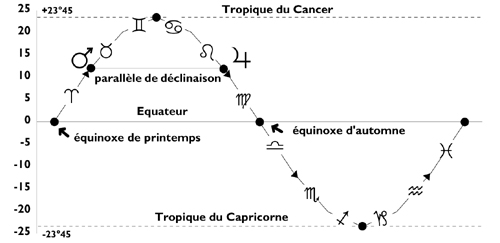
Two (or more) planets having the same N or S declination form an aspect called “parallel of declination” or “parallel”.
Two (or more) planets having the same declination but one N and the other S form an aspect called “anti-parallel” or “contra-parallel”.
Brahy had realized that the technique he used to make his predictions did not always yield the expected results. He decided to use the parallels to see if they could provide additional information and found that the parallel aspects formed on Jupiter, especially the Mars-Jupiter parallel and the Saturn-Uranus parallel have a strong influence on the financial markets and scholarship holders. Thereafter Brahy constantly used the information provided by the parallels of declination in his forecasts.
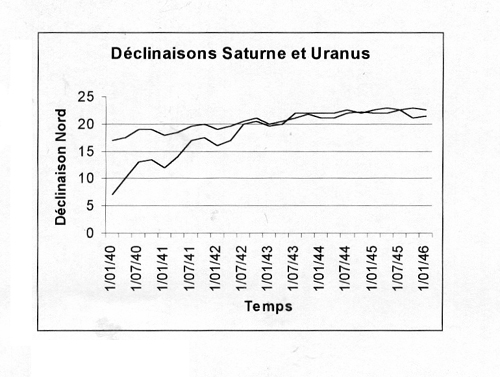
These parallels of declination are so important that by studying only those formed by the five slow planets during the 20th century, we find the main events that marked the world in the last century. The principle used by Brahy is to draw a diagram where the ordinates show the variations of N and S declination of the slow planets as a function of time for the period from 1900 to 2000. When several planets, generally at least three, have near declination, events occur on Earth of considerable importance. We find there for example the Transvaal war, the Russo-Japanese war of 1905, the Russian revolution of 1917, the second world war, etc.
By studying more particularly the variations of declination of the slow planets during the Second World War, Brahy establishes a parallel with the victories of Nazi Germany and the variations of declination of the planet Uranus, and a parallel between the victories of the Allies and the variations declination of the planet Saturn.
As long as the N declination of Uranus is greater than that of Saturn, the Axis Powers (Germany, Italy and Japan) fly from victory to victory. From 2nd quarter of 1943, the N declination of Saturn is greater than that of Uranus and the defeats accumulate: Italian capitulation, Stalingrad disaster, Normandy landings, etc.
At the end of 1944, the N declination of Uranus exceeded that of Saturn and it was the Arnhem disaster and the von Runstedt counter-offensive which almost reversed the course of the war but which fortunately failed… when Saturn again exceeded Uranus in N declination.
We could still write many pages on the work of this innovator, Gustave-Lambert Brahy, but the essential thing to remember is that for the first time in a very long time, an astrologer is using astrometric data to base his method of work and therein lies the great merit of it.
.png)
.png)
.png)
Born on 01/03/1898 in Turin and died on 05/10/1978, Henry-Joseph Gouchon, also known by the pseudonyms of Sélénius and Régulus, was the Honorary President of International Center of Astrology.
Certainly he is best known to the general public as the “great specialist” of the technique of “primary directions” but what should be remembered above all is that Gouchon, like Brahy, uses astrometric data as the foundations of astrology.
Faced with the monumental failure of the “no forecast” by astrologers, of the world conflict of 1939–1945, Gouchon conceives “Slow Planet Concentration Index” which is a new process for analyzing forecasts in the astro-world. The process for constructing this index is relatively simple: “it suffices to measure the arc of a circle that encompasses the four slow-moving planets Jupiter-Saturn-Uranus and Neptune (at the beginning Pluto was not taken into account and even at the present time it does not seem necessary to include). You can measure in both directions and take the lower number.” The measurement of this arc of a circle is carried in ordinate, the abscissa being the time (the unit chosen here being for example the 1st January of each year) and we obtain the following graph:
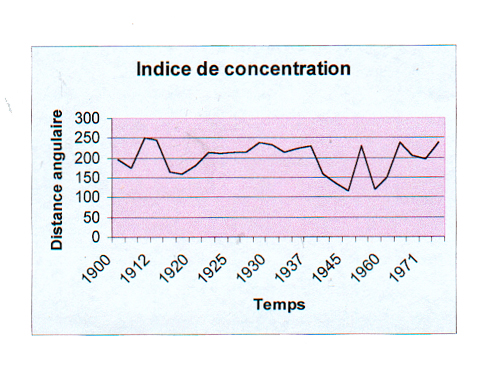
When the index is high, humanity is not in big trouble and when the index is low, the world is in very difficult times (14–18, 40–45, etc.). In reality this index does not measure a planetary concentration but a (minimal) framing arc measuring the distance which separates the first from the last slow planet (except Pluto) on the ecliptic and common sense makes it easy to understand that at Within a given frame, it is not possible to know if the planets are dispersed along the arc or if there are planetary concentrations. It is an index that uses the reference “space”, just like the Barbault Cyclical Index, of which it is the precursor.
For the record, you should know that it was in 1940 that the idea of this index arose in Gouchon’s mind, but as his analysis suggested that the war would continue for another four or five years, the astrologer did not did not believe it!
Chronologically, I should have first spoken of Armand Barbault before speaking of Henry-Joseph Gouchon, but the “astrological destiny” of the two Barbault brothers is so intimately linked, that it seemed logical to me to speak about it now jointly.
.png)
.png)
.png)
Armand Barbault, pseudonym Rumélius, was born on 02/04/1906 and died on 02/05/1974. A radio-technician engineer, Armand Barbault took an early interest in astrology and “he writes, in a monthly called L’Avenir du monde, a series of articles forming a study which he calls ‘The chart of the 20th century’, where he reconnects with a vanished tradition relating to planetary cycles”.
No more than other astrologers of the time, Armand Barbault could predict the Second World War, but based on the study of the great conjunctions of 1940–1942, similar to those of 1914–1918, he nevertheless foresees for this period very serious difficulties. In reality Jupiter, Saturn and Uranus will find themselves in the sign of Taurus for many months and Armand Barbault foresees serious economic difficulties and even famines.
The eldest of the Barbaults is the initiator of the “planetary cycle theory”. For him, it is not enough to study the major conjunctions but it is necessary to study the different aspects of the cycle in its development from the initial conjunction to the following conjunction, passing through the intermediate aspects. Thanks to this technique, it is possible to follow a historical, political, social or other phenomenon and to predict its outcome.
Armand Barbault could have become an emblematic figure of astrology but besides being modest and discreet, he would devote the last years of his life to the study of alchemy.
.png)
.png)
.png)
Armand’s younger brother Barbault, André, was born on 01/10/1921. He made his debut under the tutelage of his brother and very quickly became passionate about global astrology. First with his brother and then on his own, he experimented with “planetary cycle theory” in astro-global and succeeds in some remarkable predictions. The principle he uses is to correlate major conjunctions with a series of historical events: the Saturn-Uranus cycle and the future of the USA; the Saturn-Neptune cycle and the U.S.S.R.; the Jupiter-Saturn cycle and Europe or the Saturn-Pluto cycle and China.
However, a somewhat in-depth study is enough to show that if there is sometimes a disturbing correlation between the study of the cycle of a great conjunction and the future of a country (USSR and the Saturn-Neptune cycle), sometimes also this correlation does not play or little (USA and the Saturn-Uranus cycle or Japan and the Uranus-Pluto cycle). There are many examples of this kind and even if André Barbault manages to predict a series of end of hostilities (Algeria, Santo Domingo, Yemen, Pakistan or Vietnam) with the help of the study of the Sun-Jupiter cycle, he we must recognize that the correlation cycle and becoming of a nation is insufficient. On the other hand, the same cycle can concern different states such as the Saturn-Pluto cycle which is supposed to punctuate the future of China but also that of the late FRG… And here again one can wonder about the merits of correlating a single cycle to the future of several countries because we are assured of “always get your predictions right”…
This line of research seeming too limited, André Barbault strives to find even a partial solution to this problem. He knows the work of Gouchon and his planetary concentration index and in 1973 realizing the insufficiency of the Gouchon index (Gouchon himself used this index simply as an additional indicator), he will substitute “a system model more appropriate to the representation of the reality dealt with, this being precisely the phenomenon of the planetary cycle, since the distances between planets”: the cyclical index.
The cyclical index is obtained “taking the planet-to-planet angle distances; it is the result of the addition of the ten distances of the ten cycles: Jupiter-Saturn, Jupiter-Uranus,… Uranus-Pluto, Neptune-Pluto” my article on concentrations-dispersions of declinations, I showed you how to obtain this index and we obtain the following curve for the 20th century:
The diagram drawn allows the following conclusions to be deduced:
▶ 1. The cyclical index is rising when the planets are in phase separation (the faster planets moving away from the slower ones) and humanity experiences calmer periods than usual.
▶ 2. The cyclical index is descending when the planets are in the phase of application (the faster planets approaching, after their opposition, the slower ones) and humanity experiences turbulent periods characterized by deep crises.
▶ 3. The troughs of the curve correspond to periods of planetary concentration (great conjunctions) and the peaks of the curve correspond to periods when planetary oppositions are preponderant.
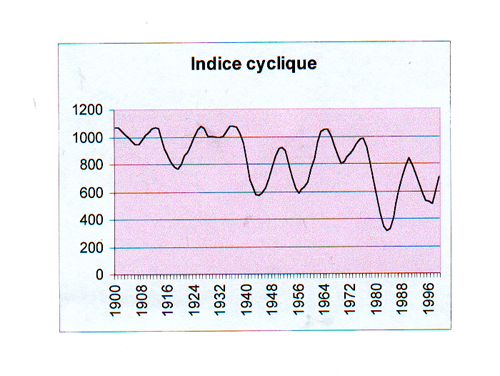
By examining this graph, we find that the hollows that appear correspond to events such as the 14–18 war, the great economic crisis of 1929–1932, the 39–45 war, the Korean war, etc. Since the troughs of the curve correspond to periods during which the majority of the planets are in the phase of application, we are not surprised to find during the war 14–18 an accumulation of 4 major conjunctions in 5 years and 5 major conjunctions in 6 years between 45 and 45; i.e. 9 major conjunctions over 11 years while the total of major conjunctions from 1900 to 1945 is 16.
We also note that the most important trough of the century is during the period from 1978 to 1984 and one could believe a priori that this should have concerned the darkest period of the century. However, contrary to what André Barbault believed, we did not experience disasters similar to those of 14/18 or 39/45, even if it must be recognized that we did not experience a period of euphoria either. In order to explain why this plunge in the cyclical index did not lead to a planetary catastrophe, we will add other indicators to this index. Astrologer Claude Ganeau “…recommended 3 regarding the factors contributing to the triggering of major global crises: 1) Presence of the 5 slow-moving stars in only one half of the zodiac (Concentration index −180°); 2) Maximum in degrees of the descending phases of the 10 cycles; 3) Gathering of several major conjunctions in the same period.” In fact, following the method recommended by Claude Ganeau, only the two world wars meet these conditions.
André Barbault will continue his research in the years that follow and relate the cyclical index to solar activity. He draws the following conclusion: “With this primary equation: Cyclic index = centration/decentration of the Sun = solar activity, we finally have the physical substrate of the phenomenology of mondiology”, but unfortunately this equation is totally false, as Jean-Pierre Nicola demonstrated in the Cahiers Conditionalistes No. 21 & 22.
It cannot be denied that André Barbault contributed to the development of global astrology, but it turns out that the assumptions on which his “global astrology” do not find their origins in the observable reality and we must therefore continue our research to see if other solutions exist…
Passionate about global astrology, I discovered conditionalist astrology by looking for information on the world! I discover La Condition solaire of J.-P. Nicola and the language of conditionalist astrology which combines rigor, logic and coherence. So I wonder if this author is also interested in global astrology…
.png)
.png)
.png)
I discover on reading Cahiers Conditionalistes that indeed J.-P. Nicola has developed a forecasting method applicable to global astrology and which, unlike other attempts, is of indisputable objectivity. André Barbault advocates the use of “theory of astrological determinations” of Morin de Villefranche in these analyzes of charts but paradoxically in his global astrology, I find no trace of it or hardly any. If, as Barbault says, the best work on global astrology is that of Morin, why does he not use it? In individual astrology he swears only by Morin but in world, he ignores it! Probably, as J.-P. Nicola points out, that André Barbault has a separate print of the “best work of global astrology, that of Morin…” but for a researcher in astrology this kind of dichotomy raises serious questions!
The SAVA index (summation advances angular velocities) that Nicola developed is based on the observable real. This index does not need to justify itself with a profusion of additional indices like the one developed by André Barbault. The Uranian, and Barbault is one of them, has this will to reduce the complex (‘T’) to the simple (‘r’) but if it is “non-E”, it is the case of Barbault, the theories that he develops even if they seem relevant and effective, are only speeches based on a false starting hypothesis. Nicola, he does not claim to have discovered the fundamental law of the world, he experiments, he thinks and from indisputable astrometric data, he develops an objective and coherent method. Barbault’s working method is based on analogical thought (symbol) and Nicola’s is based on rational thought (signal) but unlike Barbault who stubbornly refuses (Uranus) the signal, Nicola knows the importance of value of the symbol.
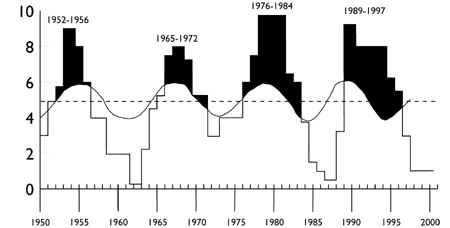
“The future being governed by the unknown, domain of Pluto, forecasting is a complex operation” and a single clue, no matter how perfect, is not enough. It is not prohibited to integrate the cycles of Mars within the SAVA index and one could even weight this index using the L/g ratios but “whatever the planetary index that we imagine, the method that we adopt, common sense (today I would say rigor) requires studying one that contains them all: that of the speeds of the constituent elements”
In most books on global astrology, subjects such as the “Great Year”, the phenomenon of precession of the equinoxes, the apogee of the Sun, the astro-cartography, the midpoints or other elements to be taken into consideration for “make a good forecast”. Without prejudging the possible contribution that these elements could bring, I think I can say that, in the current state of our knowledge, these parameters are not very useful to us with the exception perhaps of the midpoints.
The tragic events of 11/09/2001 and their direct or indirect consequences on the American and Afghan peoples were, to my knowledge, not foreseen by anyone and certainly not by Elisabeth Teissier ! This does not call into question the validity of the value of the astro-world but it should encourage us to put our claims on our ability to predict into perspective. When Charles Richet says: “All our science, our science of which we are so proud, is only the knowledge of appearances (‘R’). The bottom line (‘T’) eludes us”, it is not only addressed to the so-called official sciences but also to astrological knowledge, and should encourage us to be more humble.
Article published in issue No. 16 of the Fil d’ARIANA (October 2001).
▶ Global astrology: a method
▶ Declination concentration-dispersion index
▶ Could astrology predict the stock market crash of October 2008?
▶ Élizabeth Teissier’s avian flu
▶ Conditioning in global astrology
▶ Élizabeth Teissier, Pluto in Scorpio & the AIDS epidemic
▶ Thoughts on global astrology
▶ André Barbault, l’astro-symbolisme et le dernier âge d’or de l’astrologie
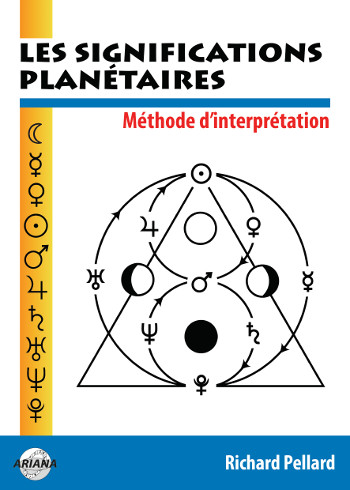
Les significations planétaires
par
620 pages. Illustrations en couleur.
La décision de ne traiter dans ce livre que des significations planétaires ne repose pas sur une sous-estimation du rôle des Signes du zodiaque et des Maisons. Le traditionnel trio Planètes-Zodiaque-Maisons est en effet l’expression d’une structure qui classe ces trois plans selon leur ordre de préséance et dans ce triptyque hiérarchisé, les Planètes occupent le premier rang.
La première partie de ce livre rassemble donc, sous une forme abondamment illustrée de schémas pédagogiques et tableaux explicatifs, une édition originale revue, augmentée et actualisée des textes consacrés aux significations planétaires telles qu’elles ont été définies par l’astrologie conditionaliste et une présentation détaillée des méthodes de hiérarchisation planétaire et d’interprétation accompagnées de nombreux exemples concrets illustrés par des Thèmes de célébrités.
La deuxième partie est consacrée, d’une part à une présentation critique des fondements traditionnels des significations planétaires, d’autre part à une présentation des rapports entre signaux et symboles, astrologie et psychologie. Enfin, la troisième partie présente brièvement les racines astrométriques des significations planétaires… et propose une voie de sortie de l’astrologie pour accéder à une plus vaste dimension noologique et spirituelle qui la prolonge et la contient.
Téléchargez-le dès maintenant dans notre boutique
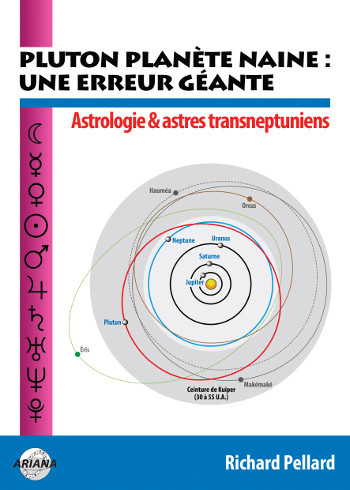
Pluton planète naine : une erreur géante
par
117 pages. Illustrations en couleur.
Pluton ne fait plus partie des planètes majeures de notre système solaire : telle est la décision prise par une infime minorité d’astronomes lors de l’Assemblée Générale de l’Union Astronomique Internationale qui s’est tenue à Prague en août 2006. Elle est reléguée au rang de “planète naine”, au même titre que les nombreux astres découverts au-delà de son orbite.
Ce livre récapitule et analyse en détail le pourquoi et le comment de cette incroyable et irrationnelle décision contestée par de très nombreux astronomes de premier plan. Quelles sont les effets de cette “nanification” de Pluton sur son statut astrologique ? Faut-il remettre en question son influence et ses significations astro-psychologiques qui semblaient avérées depuis sa découverte en 1930 ? Les “plutoniens” ont-ils cessé d’exister depuis cette décision charlatanesque ? Ce livre pose également le problème des astres transplutoniens nouvellement découverts. Quel statut astrologique et quelles influences et significations précises leur accorder ?
Enfin, cet ouvrage propose une vision unitaire du système solaire qui démontre, chiffes et arguments rationnels à l’appui, que Pluton en est toujours un élément essentiel, ce qui est loin d’être le cas pour les autres astres au-delà de son orbite. Après avoir lu ce livre, vous saurez quoi répondre à ceux qui pensent avoir trouvé, avec l’exclusion de Pluton du cortège planétaire traditionnel, un nouvel argument contre l’astrologie !
Téléchargez-le dès maintenant dans notre boutique